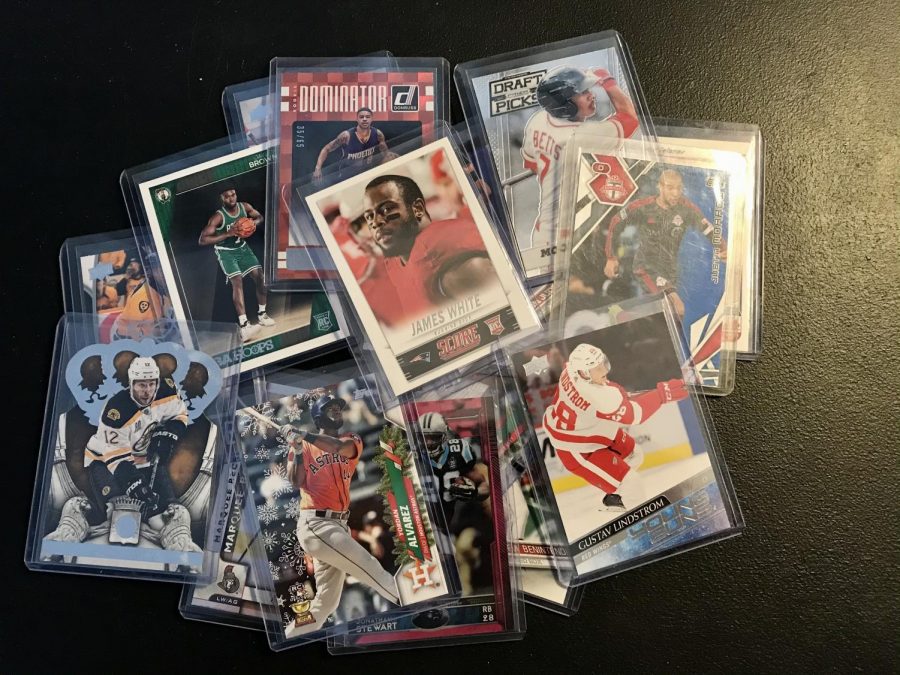COVID-19 Brings Back Sports Cards
The sports card industry capitalized on consumers stuck at home during canceled professional sports seasons.
February 26, 2021
This past summer, a Mike Trout autographed rookie card sold for $3.9 million dollars, breaking the world record for the most expensive sports card ever sold. In January of 2021, Mickey Mantle’s vaunted rookie card sold for a shocking $5.2 million dollars, shattering the record set by the Trout sale just five months earlier. The records for the most expensive basketball, football, and hockey cards sold were also blown away in 2020 and 2021. 2020 alone saw an astounding ten cards sold for at least $500,000 each. It was the year of the resurgence of sports cards, and it does not look like it will stop any time soon.
Many factors have led to the rise in sports cards over the past year. The COVID-19 pandemic forced millions of Americans to stay home, which had an adverse effect on many businesses. For the sports card industry though, it had the opposite effect. In the absence of dining out at restaurants, travel, as well as the addition of government-sponsored stimulus checks, many of those lucky enough to still have their job searched for something to spend their money on—many of whom found the sports card industry to be the perfect avenue.
The history of sports cards is not a linear one. Baseball cards have been around about as long as baseball itself, and were sold in cigarette packs in the early 1900s. They later evolved to be sold with packs of gum, and are now sold on their own. In the 1970s and 1980s, the industry really took off, as the famous Topps brand was joined by Fleer, Donruss, and Upper Deck. Other sports and their trading cards were beginning to see rises in popularity as well, but the abundance of prevalent brands, sports, and cheap prices led to an overproduction of cards.
Goldcardauctions.com estimated that “around eighty billion cards” were produced each year in the early 1990s. By the mid 1990s, regular “base” cards were worth practically nothing given the volume that they were produced at. Eventually, fans lost interest in cards that had practically no value, and the industry began losing clients; in the early 2000s, sports cards hit rock bottom.
In the years leading up to 2020, sports cards were making a slight comeback, however, 2020 saw a shocking rise in popularity. In the digital age, there are now many more opportunities for fans to engage in the hobby from their own home. No longer is the only place to buy cards at the local hobby shop, as many online sites have become extremely popular. Collectors usually have two choices to make when buying cards: they can go the route of buying individual cards, or they can buy packs or boxes of unopened cards. They can also participate in “group breaks,” which assign different participants different teams in a box of cards, so collectors only get players from the team that they support, and do not have to pay for an entire box.
Buying e-packs has also become popular. A collector can buy a pack online, and if they like some of the cards they pull, they can have them shipped to them. If they do not, they do not have to deal with the clutter of cards they do not care about around their home. The addition of game-used jersey cards and autographed cards has also added new variety and value to the hobby. In addition, videos of collectors opening boxes have become quite popular on YouTube. The sports card industry is now offering countless products for each sport, while not making the mistake of producing too many of each card as they did in the 1990s. Sites like eBay and comc.com have also led to the ability to buy and sell individual cards. Overall, the game of sports card collecting is changing drastically.
While there have been many effects on the hobby by the rise in popularity, not all are positive. Collecting sports cards has gotten much more expensive. It is difficult to buy directly from distributors as many simply buy and stash boxes that they plan on reselling for more money. They do this since, typically, unopened products consistently rise in price after being released, due to the emergence of certain players, or simply more consumer demand. The average unopened box tends to be worth much more than the actual cards inside them because of the possibilities that they possess. Grading cards (the process done by a few companies to rate a card’s condition on a scale of one to ten) has also led to an increase in price, as a card with a high grade will skyrocket in value. It does allow people to sell their cards sight unseen though, given that both the seller and buyer know exactly how well the card looks, and there is no opportunity for deception. The now expensive industry in large part plays to wealthy adults, rather than young children with a passion for a sport and collecting. Many are now viewing sports cards as an investment, rather than a hobby, and by doing so have priced out many who simply wish to enjoy the fun of ripping open packs or finding their favorite players.
Lately though, recency bias has been the most significant cause of increased prices. Basketball cards especially saw their prices skyrocket. When ESPN’s “The Last Dance,” a documentary series about Michael Jordan’s Chicago Bulls teams from the 1990s, aired, Jordan and his teammates’ card values soared. Overall, Bulls memorabilia sales rose 400%. The average price of Jordan’s cards doubled during and after the series, and a Scottie Pippen rookie card that was selling for $20 before the show started going for $100 during it, with graded tens selling for around $2,000. On September 23rd, a Tyler Herro rookie card increased in value over 200% (from $130 to $400) in one day simply because he had 37 points the night before. Herro’s cards have not been outliers either. While prices have increased for the other three major American sports, basketball’s prices have started leaving the others behind.
John List, a well known collector, told ESPN that “The sports card market [does] well because it’s part nostalgic, part art, and part investment potential. That combination is what’s magical.” Because the industry is now so popular in each of the four major sports in the US, a crash like one that happened in the 1990s is nearly impossible. That is especially true given the higher prices and number of adults in the hobby today. 2020 saw a 142% increase in sales on eBay, with over 4 million more cards sold than in 2019. The pandemic has most definitely brought sports cards back into the limelight, but whether that is a good thing or not is still to be seen.










